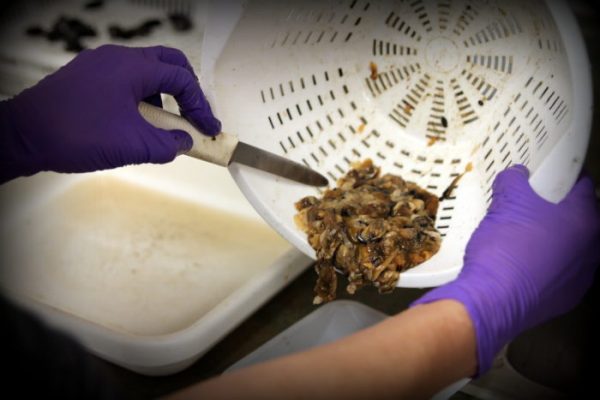
Margo Reveil and her husband have owned and operated Jakolof Oyster Co. in Homer’s Kachemak Bay for seven years.
“It’s primarily oysters,” she said. “We do a little bit of mussels and scallops, but they’re sort of a bycatch for us. Primarily oysters. I would say 99 percent.”
Reveil regularly sends samples of her oysters to a lab in Anchorage run by the state’s Department of Environmental Conservation (DEC) to make sure they’re healthy to sell. She spends around $100 to ship each sample — once a week in the summer and once a month in the winter.
The testing itself is paid for by the state. DEC Commissioner Jason Brune estimates it’s about $500 to $700 per test.
But Brune’s looking to shift some of that cost back to the industry, proposing that farms start paying half the testing costs. Eventually, he says, he’d like to see 100 percent of the testing fee fall to farmers.
“You know, for many industries the testing is paid for 100% by their industry,” he said.
The DEC lab in Anchorage is the only FDA and National Shellfish Sanitation Program-approved lab in Alaska, so it’s the only place in-state to get commercially grown shellfish tested. Brune says shellfish farms have had about a decade of completely subsidized testing, and now it’s time to start pulling back.
“We want to foster diversification of our economy,” he said, “but we also have to make sure that we’re paying attention to what should be funded and what shouldn’t be funded from the limited state resources that we have.”
Shellfish farmers in Alaska face unique challenges. It’s expensive to operate, and they’re often shipping product from far-flung areas, with unpredictable weather. Farmers like Reveil say it’s impossible to try to help the growing industry while taking away that state support.
“We can’t just raise [our] prices because we already have the competition of outside Alaska oysters, even Mexican oysters that we have to compete with,” Reveil said. “If the state wants to support this industry and see it grow into something viable, then there should be some state participation starting out.”
Oyster farming is a big commitment, according to Reveil, requiring at least 5-7 years of permitting and growing the oysters before farmers see a profit. The proposal, which would kick in in a matter of months if it passes, came as a shock. If it does pass, Reveil says they probably won’t be able to support selling oysters to Homer’s summer crowd anymore.
“It would probably push us into harvesting more in the fall, spring, winter months when we have fewer tests required,” she said. “But that’s also the more dangerous season to be over [at the farm] and harvesting, so it makes it all more stressful.”
And if they end up having to cover the full testing fee?
“At that point, it would just shut us down,” she said. “I just don’t see how a small farm can can manage that.”
The budget proposal is also a threat to farms trying to get off the ground. Erik O’Brien is in the permitting process for his oyster farm in the remote village of Larsen Bay, on Kodiak Island.
“There’s a thought that this can be an industry to diversify,” he said. “But if we throw up walls right now, I think that you’d see a lot more businesses change their perspective, go out of business and exit the industry.”
For O’Brien, shipping samples from Larsen Bay to Anchorage can cost $200 or more. That’s on top of already high fixed costs of shipping the oysters from the village to market. Add to that several hundred dollars in testing fees, and O’Brien says it’s going to limit the kind of sales he can make.
“If my fixed costs increase due to tissue samples of $700 then I have to sell 1400 oysters, just to cover fixed costs,” he said. “So now my minimum sale is couple of thousand. And that really reduces the number of people that will be able to buy that product.”
This budget item is still a proposal, subject to consideration by the legislature, which convenes next month. Brune says if it does pass, they’ll be looking to get industry comments to determine how quickly to shift testing fees to farmers.




